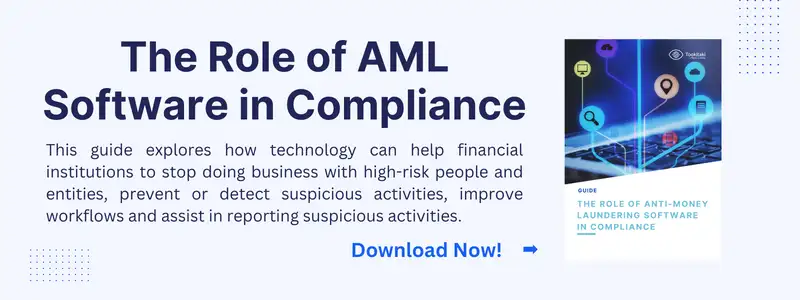The Evolution of AML in Software: A Look at the Philippine Market
The financial world is a complex ecosystem, intrinsically interwoven with the world's economy and the livelihoods of countless individuals and businesses. One crucial aspect of this ecosystem, particularly within the financial markets of countries such as the Philippines, is the battle against money laundering. Anti-money laundering (AML) measures have become a critical focus for financial institutions worldwide, and the Philippine market is no exception.
As the Philippines continues to embrace the digital age, the importance of AML in its burgeoning financial sector cannot be overstated. The country's financial landscape has experienced a rapid transformation spurred by technological advancements and the increased integration of digital platforms into everyday banking and financial services. This digital transformation has brought with it an increased risk of financial crime, making AML measures even more crucial.
In this context, the software is playing an increasingly significant role in AML processes. AML software serves as a powerful tool that empowers financial institutions to effectively detect, prevent, and combat money laundering and related criminal activities. When used effectively, these systems can provide comprehensive risk coverage, enhance detection accuracy, and significantly reduce false alerts.
In this blog, we'll explore the evolution of AML in software, with a specific focus on the Philippine market. We'll delve into how these software solutions have transformed over time, adapting to the needs of an ever-changing financial landscape and the role they play in the ongoing fight against financial crime.
The Early Stages of AML in the Philippines
The journey of anti-money laundering (AML) in the Philippines has been fascinating, marked by challenges and milestones. The initial steps towards a comprehensive AML framework began in earnest with the establishment of the Anti-Money Laundering Act (AMLA) in 2001. This legislation was a significant turning point, marking the country's formal commitment to combating money laundering.
In the early stages, implementing AML measures posed numerous challenges. The primary issue was the lack of awareness and understanding of money laundering practices and a dearth of technical expertise and resources. Compliance was viewed more as a regulatory obligation than a strategic imperative, leading to a limited commitment to robust AML controls.
Traditional methods of AML during this period relied heavily on manual processes. Financial institutions implemented transaction monitoring systems that flagged transactions based on predefined rules. These systems, while a necessary first step, were far from perfect. The rules-based approach was often overly simplistic, leading to a high number of false positives. This inundated compliance teams with alerts, many of which were not indicative of actual suspicious activity.
Moreover, these traditional methods had limitations in detecting complex money laundering schemes. Sophisticated launderers could often circumvent these rules-based systems by structuring their transactions to avoid triggering the set thresholds. This, coupled with the rapid advancement of technology and the growing sophistication of money launderers, highlighted the need for more advanced, dynamic, and intelligent AML solutions.
The Advent of Software in AML
As the limitations of traditional AML methods became increasingly apparent, the financial sector began to explore more innovative solutions. The advent of software in AML marked a significant shift in how financial institutions approached money laundering and related financial crimes.
The Emergence of Software Solutions in AML
In response to the escalating complexity of financial crime, anti-money laundering tracking systems began to emerge as a critical tool in the fight against money laundering. These solutions offered a way to automate processes, improve detection capabilities, and reduce the burden of false alerts on compliance teams. Key developments included:
- Automated Monitoring: Software allowed for the automation of transaction monitoring, drastically reducing the workload of compliance teams and allowing for more transactions to be monitored.
- Risk Scoring: Advanced software solutions introduced the concept of risk scoring, a way to rank customers based on their likelihood of engaging in illicit activities.
- Machine Learning and AI: With the advent of more sophisticated technology, software solutions began to incorporate machine learning and artificial intelligence. These technologies enabled more dynamic and adaptive detection methods, improving the accuracy of AML efforts.
The Current State of AML Software in the Philippines
We find a dynamic and robust landscape as we delve into the present state of Anti-Money Laundering (AML) software in the Philippines. The integration of software in AML processes has now become a norm, marking a significant departure from the traditional methods that once dominated the sector.
Key Players and Their Contributions
Several key players have emerged in this evolving landscape, each contributing to the strengthening of AML measures in their unique way. While it would be imprudent to name specific companies in this discussion, we can safely say that these firms range from established global software vendors offering comprehensive AML solutions to innovative startups leveraging cutting-edge technology to disrupt the status quo. Their offerings typically include transaction monitoring systems, customer risk scoring, and automated reporting tools, among other features.
One notable trend among these providers is the use of machine learning and artificial intelligence in their solutions. These technologies enhance the detection capabilities of AML software, allowing it to learn from past data, adapt to new patterns, and identify suspicious activities with greater accuracy and efficiency.
Improvements and Advancements Brought About by AML Software
The advancements brought about by AML software in the Philippines are manifold. The ability to automate routine tasks has reduced the workload of compliance teams and minimized human error. This has resulted in more accurate detection and reporting of suspicious activities, ultimately leading to more effective prevention and mitigation of money laundering.
Furthermore, advanced technologies like machine learning and AI have greatly improved AML efforts' precision. These technologies have given software the ability to recognize complex patterns and anomalies, enabling it to detect sophisticated money laundering schemes that may have gone unnoticed by traditional methods.
The integration of software into AML processes has also improved the scalability of these efforts. With software, financial institutions can monitor a significantly larger volume of transactions in real time, a feat that would be impossible with manual methods.
In essence, the advent of AML software has revolutionized the Philippine financial sector's approach to money laundering. As we look to the future, we can only expect this trend to continue, as more advanced technologies come into play and the fight against financial crime becomes increasingly digital.
The Role of AML Software in Overcoming Challenges
While the advent of software in AML has certainly made strides in the Philippine financial landscape, it is not without its own unique set of challenges. From dealing with a complex regulatory landscape to navigating the multifaceted aspects of customer transactions, the Philippine AML landscape presents its own share of obstacles. Fortunately, advancements in AML software technology have proven effective in addressing many of these challenges.
Leveraging AI for Enhanced Detection
One of the fundamental challenges in AML efforts is the detection of suspicious transactions. While effective to a degree, traditional rules-based systems often fall short in terms of efficiency and accuracy. However, the application of AI and machine learning (ML) in AML software has led to significant improvements in detection efforts.
Automating Processes for Cost Efficiency
Another challenge in AML efforts is the cost and time associated with manual customer onboarding processes. By leveraging robotic process automation, AML software has significantly reduced the time and cost associated with these processes.
Modernization and Digital Transformation
Finally, one of the more complex challenges in the Philippine AML landscape is the modernization of legacy systems and infrastructures. AML software solutions have played a pivotal role in facilitating digital transformation and modernization efforts in financial institutions.
These examples underscore AML software's critical role in overcoming challenges in the Philippine AML landscape. Through leveraging AI for enhanced detection, automating processes for cost efficiency, and facilitating digital transformation, AML software is proving to be a game changer in the battle against money laundering.
Tookitaki's Role in the Evolution of AML in the Philippines
In the landscape of AML compliance, one name that is making significant strides in the Philippine market is Tookitaki. With its innovative solutions and groundbreaking approach to AML, Tookitaki is contributing notably to the country's evolution and modernization of AML processes.
Transforming Compliance with the AMLS
At the heart of Tookitaki's contributions is its pioneering Anti-Money Laundering Suite (AMLS). AMLS is an end-to-end operating system designed to modernize the compliance processes for banks and fintech businesses. It offers comprehensive risk coverage, enhanced detection accuracy, and a significant reduction in false alerts, all of which are crucial in effective AML efforts.
The AMLS consists of several key modules, each designed to address a specific aspect of AML compliance:
- Smart Screening Solutions: They include Prospect Screening, Name Screening, and Transaction Screening. These tools enable financial institutions to screen names against various watchlists, sanction lists and adverse media with superior accuracy.
- Dynamic Risk Scoring: This involves Prospect Risk Scoring and Customer Risk Scoring. These mechanisms provide a dynamic assessment of risk associated with prospects and customers, allowing for proactive risk management.
- Transaction Monitoring: This module monitors transactions for any suspicious activities, providing another layer of protection against potential money laundering.
- Case Manager: This tool facilitates the management and tracking of cases, enhancing the efficiency and effectiveness of investigations.
The modular design of the AMLS allows for flexibility and customization to suit the specific needs of each institution, further enhancing its relevance and utility in the Philippine financial sector.
.png?width=700&height=875&name=AMLS%20Modules%20(1).png)
The Impact of Tookitaki's Solutions
Tookitaki's AMLS has brought about significant improvements and advancements in the Philippine AML landscape. Tookitaki provides a level of detection accuracy and efficiency that surpasses traditional methods. This, combined with its comprehensive coverage and reduced false alerts, contributes to a sustainable AML program.
Moreover, Tookitaki is not just about providing innovative technology; it also fosters a community of experts through its Anti-Financial Crime (AFC) Ecosystem. This unique approach ensures that financial institutions stay ahead of the curve in their AML programs and promotes a collaborative and united effort in the battle against financial crime.
The Future of AML Software in the Philippines
As we look ahead, the future of Anti-Money Laundering (AML) software in the Philippines is both exciting and promising. Emerging trends and technologies are poised to bring about significant advancements that could revolutionize AML processes and systems. Let's take a closer look at what's on the horizon and how these developments could impact the Philippine market.
- AI and ML are not new in the realm of AML software, but their applications continue to evolve and expand. Advanced AI algorithms and ML models are being developed to improve detection accuracy, reduce false positives, and further streamline compliance processes. As these technologies become more sophisticated, we can expect even more efficient and effective AML systems.
- Another promising development is the application of blockchain technology in AML processes. Blockchain's decentralized and transparent nature can help reduce the risk of fraud and improve traceability in financial transactions, making it a powerful tool in the fight against money laundering.
- Regulatory Technology, or RegTech, is gaining traction as a solution to the ever-increasing complexity of regulatory compliance. RegTech solutions leverage technologies like big data analytics, cloud computing, and AI to simplify compliance management and ensure regulatory adherence.
Potential Impact and Benefits
These advancements in AML software are set to bring numerous benefits to the Philippine financial market. Improved detection capabilities and streamlined processes will enhance the effectiveness of AML efforts. The integration of technologies like blockchain and RegTech can increase transparency, improve traceability, and simplify compliance management, leading to more robust and efficient AML systems.
Moreover, these technologies could also bring economic benefits. By reducing the costs associated with compliance management and fraud losses, financial institutions could potentially realize significant savings, which could then be channelled into more productive areas.
The Role of Regulatory Bodies and Financial Institutions
Adopting these emerging technologies in AML processes will require a collaborative effort from regulatory bodies and financial institutions. Regulatory bodies must provide clear guidance and regulations to ensure these technologies are used ethically and responsibly. They also have a role to play in fostering an environment that encourages innovation and the adoption of these technologies.
On the other hand, financial institutions must be proactive in staying abreast of these developments and integrating them into their AML processes. This will involve investing in the necessary infrastructure and training to effectively use these technologies.
Navigating the Road Ahead in AML Software Evolution
As we take a step back and reflect on the journey we've traversed, the evolution of AML in software within the Philippine context is nothing short of remarkable. From the early stages, marked by traditional methods burdened with limitations, we've witnessed a transformative shift towards a more modern and sophisticated approach, thanks to the advent of software solutions in AML.
The significance of continued innovation and adoption in this field cannot be overstated. In a world where financial crime is continually evolving, staying ahead of the curve is paramount. This spirit of innovation has driven the development of more advanced and efficient systems, paving the way for a more robust and effective approach to AML in the Philippines.
Companies like Tookitaki have been instrumental in this evolution. By developing state-of-the-art solutions like the AMLS, they empower financial institutions to modernize their compliance processes, provide comprehensive risk coverage, and significantly reduce false alerts.
The future of AML software in the Philippines is promising, teeming with emerging trends and technologies that are set to bring about even more significant advancements. As we navigate this road ahead, the role of companies like Tookitaki in leading this evolution will be more crucial than ever.
We encourage all financial institutions in the Philippines to take a proactive step towards strengthening their AML efforts. Book a demo for Tookitaki’s AMLS, and witness first-hand how our innovative solutions can revolutionize your compliance processes. Join us in leading the evolution of AML in the Philippines, and together, let's make a difference in the fight against financial crime.
Anti-Financial Crime Compliance with Tookitaki?




